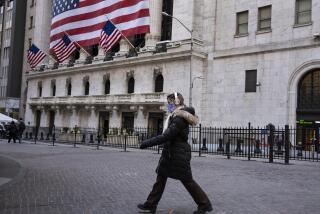Lack of Bulls May Signal That Stocks Are Ready to Soar
Trying to find a bull on Wall Street these days is like trying to find someone who voted for Bush/Quayle in 1988: You know they’re out there, but most are too sheepish to admit it.
In the peculiar ways of the stock market, however, the dearth of forthright bulls may actually be a sign that prices have bottomed and that it’s time to buy.
Just how bad is the mood?
* The Chartcraft investors’ service, which polls 135 investment newsletter writers weekly, says this week’s tally shows only 35.2% of the advisers are bullish--the lowest this year. The rest are either outright bears or believe that the market is headed for a deeper, if temporary, decline.
* The American Assn. of Individual Investors’ weekly poll, a random sampling of 125 of the group’s 125,000 members, showed only 21% bullish as of last week. That too is a 1992 low.
* James Schmidt, whose Timer Digest newsletter in Greenwich, Conn., tracks opinions of dozens of investment newsletters, has seen a marked change since June 1 in how the pros couch their forecasts. “Even many of them whom we might identify as bullish (fundamentally) have a tone that sounds very bearish,” he says.
Both professional and novice investors are reacting to the same negative news, of course: The economic recovery is suddenly suspect again, after the surge in unemployment in June; a rash of companies have “pre-announced” that their second-quarter earnings won’t look good; and the three-way presidential race is giving Wall Street a big dose of what it hates most--uncertainty.
Surprisingly, however, investors’ bearish rumblings haven’t been backed up with a lot of action. Despite some dramatic selloffs in individual stocks lately, the Standard & Poor’s index of 500 blue chip stocks has managed to inch up 3.6% from its mid-June low through Thursday.
That suggests that many investors are bears in name only--and that what they really want to do is buy stocks.
The sentiment polls, in fact, have historically been highly accurate “contrary” indicators. Whenever too many people say they’re bullish, it’s usually a sign of a short-term market peak. And whenever too many claim to be bearish, it frequently signals that stocks are poised to soar.
The Chartcraft survey, for example, showed 60% of investment advisers were bullish in mid-January--at exactly the point that many stocks reached their peaks in the bull-market surge that had begun a year earlier.
Likewise, the AAII bullish reading reached its spring low of 35% early in April, just before the Dow industrials rocketed 200 points.
These polls aren’t foolproof as trading guides. But in a year when even the savviest traders have had extreme difficulty timing the market, investor sentiment may be as good a gauge as any for spotting good entry points, Wall Streeters say.
Mark Strome, whose Santa Monica money management firm of Strome, Susskind & Co. trades actively, says the sharp decline in investor bullishness is one reason why he is reluctant to “short” many smaller NASDAQ stocks.
Short sellers, who bet on a stock’s plunge, have made good money this year as smaller stocks in general have tumbled. But Strome says sentiment over NASDAQ stocks in particular “looks too panicky now,” which could herald a bottom in that market. Indeed, the NASDAQ composite stock issue scored a sharp gain on Thursday, adding 7.18 points to 564.75, a 1.3% rise. Yet the index remains down 12% from its January peak.
One lonely raging bull is John Hussman, who writes the Hussman Econometrics newsletter from Palo Alto. He’s telling his subscribers that the market now offers “the best buying opportunity that you’ll get for the next 12 months.”
So far this year, Hussman ranks as Timer Digest’s top market timer. His 20-stock model portfolio is up 11.8% since Dec. 31, while the S&P; 500 index is virtually flat.
Hussman, who scoffs at worries about another recession, believes that investors are at a crucial turning point. With short-term interest rates at 30-year lows and the economy signaling that inflation is all but dead, only one ingredient has been missing from the stock market’s fuel mix: a drop in long-term interest rates.
But look at the bond rally that began last week, Hussman says. It’s telling you that investors finally see no reason to keep long-term rates at such high levels relative to inflation.
Couple a decline in long-term rates with the huge number of investors loitering forlornly in the bear camp, and Hussman sees a stock market ready to bust out. He expects the Dow to rally 15% from current levels, and believes that smaller stocks will post even better gains.
Bullish Sentiment Plunges
The percentage of individual investors who are bullish on stocks fell last week to the lowest level of the year, according to a weekly survey by the American Assn. of Individual Investors. That suggests that the market’s recent selling wave may be cresting, some experts say.
AAII BULLISH SENTIMENT INDEX
July 2: 21%
Source: American Assn. of Individual Investors
More to Read
Inside the business of entertainment
The Wide Shot brings you news, analysis and insights on everything from streaming wars to production — and what it all means for the future.
You may occasionally receive promotional content from the Los Angeles Times.










